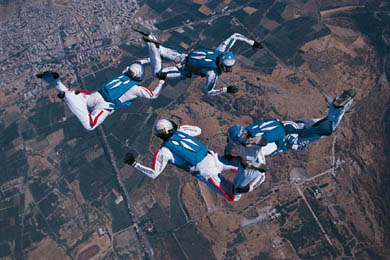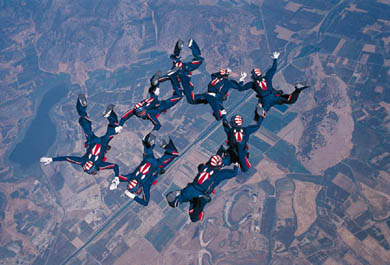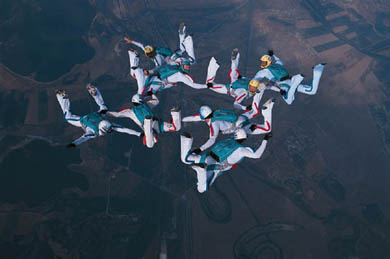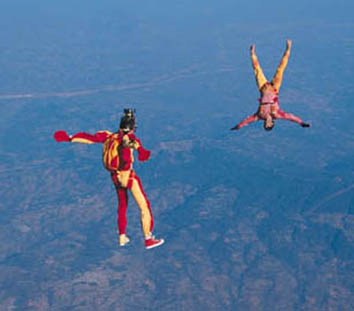

Warning: the English translations in this text may not all be correct. Thanks for your comprehension and please address any comment to me (Jean-Francois RIPOCHE, ripoche@enstay.ensta.fr).

Located in Ephese where the attractions of roman ruins go together with the Turk culture and way of life , skydiving was better off than some other disciplines, dispatched in this rocky and rather dry country. The airport was about ten kilometres from the coast of the Aegean Sea where millions of tourists pile up more than 6 months a year. During these 2 weeks of September, almost 700 people, competitors, judges and members of the organisation team changed the usual slow pace of this part of Turkey. The week before the meet was open for all teams willing to make training jumps: every country had a tent, rooms were ready for the judges, the press and the video, food was served under a big top and there were 4 Casas (31 place) of the Turkish air force as well as 2 Cessna Caravans (11 place).
Most of all, that time was used by P. Girardin the director of the competition to coordinate the Turkish people involved in the organisation. At the end of the meet, many competitors congratulated him and his assistants (P. Favier, JF Prunier, Martin and D. Tat) for their efficiency, without nothing would have been possible, especially the 10 rounds in each discipline. Friday, September 12th, all teams were present: 38 in 4-way, 13 in 8-way, 24 in skysurf and 31 in freestyle. Due to the lack of equipment, live judgement was impossible. Just after landing, videomen had to make a copy of their tape for the judges. Competitors and fans were also disappointed by the absence of a big screen for the projection of the live championship jumps. The live emotion and suspense, felt by all in Gap 95, was not to be in Turkey.

Saturday 13th, three 4-way rounds were scheduled in the morning before the afternoon opening ceremony. RW teams jumped from the tailgate of a Casa flying at 110 knots. Everybody awaited the match between the favourites: France and the American World Champions, "Airspeed". At that time, one also wondered which other teams could join the fight. During the World Games that took place in August in Finland, South Africa appeared as a possible challenger. First round, France and the United States were on the same plane. France came in strong and scored 25 pts in time. Then just before break-off altitude, and after the 35th second, Davide Moy dislocated his shoulder. We knew it to be fragile after a shock last April during a training jump that forced Davide to jump with a strapping. With this dramatic turn of events, was France out of the game? Fortunately, Davide managed to deploy his main and land without any problem.

The French 4-way team
The USA team scored 26 and South Africa 25. This first round was rapidly over and one hour after their landing, the French were called for the second round. Moy is out, Jerome David, coach and substitute of the team took his place for this round. The coach had to fly like in the old days. In the plane, he was alone with his thoughts and it sure not an easy moment for him. The tailgate opened. The members of the French 4-way expressed their trust in each other. An everlasting red light and the green ready. They moved to the edge, J. David placed his feet cautiously, as a good exit begins with good preparation. Flex and go. Good luck to the French team, carried away by the wind of the Casa, while they go to the second and third points with Jean-Pierre Roy, the videoman, as the only witness.
35 seconds later, they had 19 points, the USA and Sth. Africa had 20. J. David, T. Boitieux and the Ferré brothers saved the day. They hardly had time to pull themselves together and they were called for the 3rd round. J. David was sick in the plane and the team chose not to jump (3rd round, USA: 18, S. A.: 16). Sunday 14th, Moy's shoulder was feeling better, he was put back into the team with a big bandage around the top of his chest with care by the team's doctor. They jump for the third round and score 17. They were now tied with the South Africans but the US remained ahead with a 3 point lead.
The morning went on with the first 8-way round. The members of the Golden Knights (USA, world champions in 95) appeared serene, lucid and confident. A fair number of fans took them to the boarding area, holding the stars and stripes banner. This Army team won a tclose competition against the French in 95. Since then, 3 new knights have been trained, pushed to the summit of excellent technique and self-confidence by their teammates. Every other year, after the world championship, the 2 or 3 most experienced Golden Knights leave the team after 6 to 8 years of dedicated duty to this team. They are replaced by young skydivers who got through all the selection process. The French team looked good too but they were not playing in the same division. No other team was, the American 8-way team was head and shoulders above the rest. They won the competition with a 53 pt lead on the Russians and 69 pts ahead of the French.
There was no competition in the 8-way event, the top three teams were rapidly out of reach and at their rank. The Golden Knights, disappointed by the lack of any real challenger, decided to compete against themselves. Scott Rhodes, team leader and now 6 times 8-way RW world champion put pressure on his team declaring to TV press that they were to win with a 22+ point average and that they would want to break the world record twice during the meet. Even without opponents, the golden knights had decided to shine. And in every round, we saw a great 8-way formation skydiving demonstration. Before boarding, they were already fully concentrated, booties on, harness buckles tightened.

The Golden Knights
During the climb to altitude, they behaved as if they had a serious challenger for the gold medal. They did not allow themselves to relax for a second up to the jump altitude where S. Rhodes would give the last mission-like recommendations. In round 4, they scored 30 pts in time, a new world record improving the one they had established 2 years ago in Gap (25 pts). In front of the big scoring board, everybody is filled with admiration. Numerous competitors went to congratulate them. For the eighth round, they broke their record with 31 points. The jump was very fast, without mistakes and crystal clear. For 50 seconds, the 8 Golden Knights were on the same wavelength with 1 point every second and a half. A dream jump. S. Rhodes landed and exclaimed : "It's the best FS of my life!", which was of course also true his teammates. For a total achievement, the Knights reached their goal with a 22.4 average. Talent was crowned with success.
The Russians ended the competition with an average of 17.1, 1.8 point more than 2 years ago. However, they were not regular on the 10 rounds, getting some poor scores on a few jumps, not necessarily the more technically demanding ones. With 15.5, the French team completed a good competition for their level. In a few months, the coach, Philippe Schorno, made them progress although they had seemed to be stuck at the beginning of the season. Of course, some teams asked why the winning team of the French championship was not sent to Turkey but the good jumps of the French muffled this unanswered question. It was the first international meet for the members of this young 8-way French team and they went through it proudly. The jumps were clean and regular (only one fault in round 9). One may regret not to have had the possibility of seeing their worth under the pressure of serious opponents. On the 3rd step of the podium, they had reached the goal given by the national technical staff.

The French 8-way Team
It was a positive experience for this team whose members claim they want to be world champions in 99. We can only support such an appetite, but it must not blind us: the distance between the french and the Americans has never been so great. Their average will need a 7 pt leap in 2 years (considering the Americans remain at the same level) for them to win. If they succeed, they will prove that faith can move mountains. If not, the technical staff could be accused of having persisted in the wrong choice after the 95 meet, when the whole experience acquired in 8-way RW was thrown away. Time will pass...everybody might even accept what was reproached to the former team: being forever second.
Let's go back to the 4-way competition. We are on Monday 15th and the gap between the leading teams widened slowly after rounds 4 and 5 : Airspeed 114 pts, the French 108 pts and S. Africa 101 pts. The French made good jumps but the Americans remained superior. The French tactics seemed to consist of remaining hot on the heels of the US team, waiting for their mistakes. Patience seemed to pay : in round 6, Airspeed got a penalty and scored 17-2=15 while France got 16, trailing by five. After a one day break during which 8-way, freestyle and skysurf competitions kept going, 4-way teams started the 7th round on Wednesday. The US and French teams were in the same plane. Davide, Marin, Martial and Thierry looked confident and concentrated, putting pressure on the US team. After this jump, both teams scored 20 pts. Pressure built up, a bad jump was as likely as a very good one for the next round.
Jump after jump, South Africa strengthened their third place had with Russia behind, but they did not match France. At the boarding for the 8th round, American fans had all their flags out while French fans cheered for their team. One could feel the pressure in the air as the teams disappeared into the plane. As usual, the French went first making a good jump with 21 points. Then big surprise, the Americans were sanctioned for 3 faults (minus 6 pts) and added only 16 to their total, they were now tied with the French. Airspeed faces were pale, it was the end of the day. Guess Ho had the best night ? Thursday 18th, last day of the competition and 9th 4-way round. American and French fans cheered for their teams. In the plane, the faces of the French still looked the same. The Americans did mental rehearsals.
3000 metres and the plane is on run-in. Green light, the French team move down to the tailgate and go. Less than ten metres away from the plane, 2 formations were already built. They scored 20, while Airspeed got 21 and a 1 pt lead. Last round, Airspeed won with 24 against 21 to keep the Excalibur. At the end of this event and despite their gold medal, Airspeed were disappointed by their performance. They explained it by the lack of training (only 500 jumps of 4-way since Gap). The American team has not improved since 95 and the same goes for France (20.5 in 95 and 20.6 this year). Yet, the French had made 2500 training jumps in 2 years.
If they had progressed by 2 points, as was the case from one world championship to the next between 1987 and 1995, the French would maybe have beaten an American team by these standards. Did we miss the bus? The goal of the technical staff of the French skydiving association was not reached, they were to be World champions. What was the mistake: counting the eggs before they are hatched, the selection of the team or the training program imposed by the coach? Or was it all the fault of D. Moy's wounded shoulder? Nobody knows how it affected the team. The members of the French 4-way and 8-way teams did their best with what they were given and they can be proud of results. They can be congratulated but one must not forget that the silver medal could have been gold and that the bronze was obtained 69pts behind the winners. After all, France would win the 4-way competition from 87 to 93 and be a danger to the USA in 8-way from 91 to 95. With this past, plus 2 coaches, a manager for the national teams and a national director, people might demand better results, mightn't they?. Or must we take it as a change in the wheel of fortune, think what years of glory will come back and after all these results are not so bad...?
In the meantime, freestyle and skysurf competitions took place, although with so many less participants, these events were a bit hidden by relative work. For the first time, they were recognised by the FAI, which makes the winners official world champions. Each discipline was split between Men and Women categories. As usual, the teams were made of the freestyler or skysurfer and the videoman whose work was taken into account by the judges. Several teams could compete for the same country and competitors of 2 different nationalities could be in the same team which made the scoring board difficult to understand. It was difficuilt to know who was who and which country they were from. An Englishman and a German were in one of the US freestyle teams ! To participate, a team had to pay the entry fees and name the country they would jump for.
Women freestyle
First big surprise: Dale Stuart arrived in Turkey and announced that she could not compete because of shoulder which had already another dislocated earlier in the season. Her victory was certain, with her videoman Greg Gasson, they were above the rest and had shown it in Finland in August. As one woman's sorrow is another's joy, it was Shifumi from Japan who was favourite to win. But two Swiss teams went for the gold and silver. Nelly Pechverty's (France, filmed by her father Alain) performance was full of promising talents was to be noted.
Men freestyle
Nothing can be added to Omar's jumps. They were almost perfect, almost each time and they were filmed with a lot of talent and a faultless centering by Orly King. Those two have been in charge from the beginning until the end of the world championship. Omar, freestyler with the soul of a freeflyer, controls his body in the air and knows how to show it to the judges. The second was Scott Smith whose sky presence was compensated by a good technique and followed very well by Peter Raymond. The third place could have been for Nicolas Arnaud filmed by Willy Boeykens but it was for Olav Zipser. The French freestyler was behind the freefly clown number 1 from round 3 on. He did not expect that and thought the judges did not realise the difficulty of the triple twist loop that he was the only one to present. Nevertheless, Olav seduced with a totaly original program performed at very high vertical speed and videoed head down all the way by the talented English freeflyer Adrian Nicholas. Throughout the whole competition, Olav jumped with bare chest, legs and feet.

Omar Alhegelan, filmed by Orly King
Men skysurfing
The Swiss team, Olivier Furrer and Christian Schmidt, surpassed the rest at every round as was to be expected. For the silver, one wondered if the Brazilian team (Chofard and Padua) did no deserve it more than the other Swiss team Klaus and Pacheco.

(Photo Wendy Smith)
Women skysurfing
The competition was not very thrilling for Vivianne Wegrath who is so far ahead of the other 3 competing teams but they made a womens skysurf event happen ! She was filmed by Marcus Heggli, substitute for the poor Rickster Powell who broke his pelvis and femur after a very bad landing in August. Freestyle and skysurf competitors are still wondering if the judging is really fair and related to their performances. It is a certain fact that, in order to win, one had to convince the judges of one's technique and that is precisely what the winners did. These four are indisputable world champions.
Saturday September 20th, closing ceremony and awarding of the skydiving
medals. The podium at ground level is hidden by photographs. The athletes
were not brought out enough. Skydivers are really the best people: for
the love of their sport, they take with a smile every mistake imposed on
them. Sunday, closing ceremony of the 1st World Air Games. Monday, time
to go home, competitors did not want to miss their plane. There were good
times during these world championships but hopefully the next one will
take place in a more organised country, if only for the participants and
their passionate commitment to our sport.